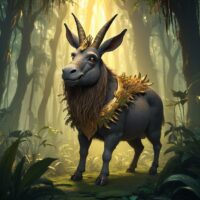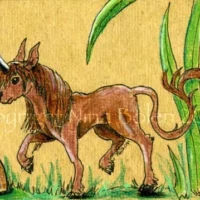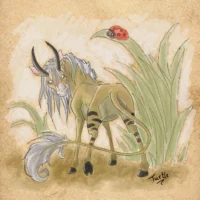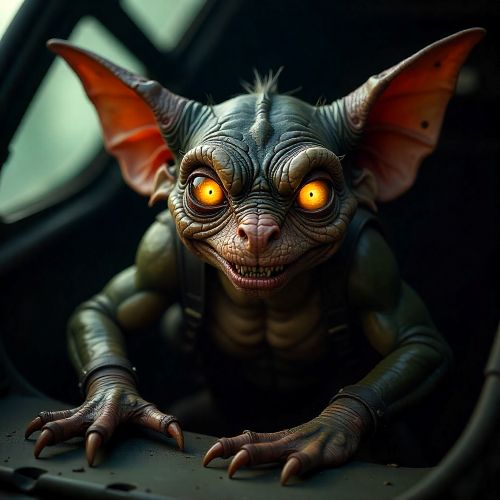Listen
At a glance
| Description | |
|---|---|
| Origin | Kongo Mythology |
| Classification | Animals |
| Family Members | N/A |
| Region | Democratic Republic of the Congo, Republic of the Congo, and Angola |
| Associated With | Healing |
Abada
Introduction
In the rich tapestry of African mythology, one creature stands out for its quiet strength and mystical presence: the Abada. Hailing from Kongo mythology, this legendary beast is often referred to as a type of unicorn—but it’s far more than a simple counterpart to its European cousin. Unlike the delicate, singular-horned unicorns of Western tales, the Abada is a grounded, magical figure believed to hold potent healing powers. As part of Central African folklore, it represents more than just myth—it is a symbol of protection, spiritual wisdom, and cultural heritage.
Physical Traits
Visually, the Abada strikes a balance between the familiar and the fantastical. About the size of a small donkey, it appears sturdy and compact—built for resilience rather than elegance. Its body is typically described as dark-colored, sometimes with a rough or bristled texture, and it sports a tail much like that of a wild boar. This combination of traits gives it an almost rugged charm.
What sets the Abada apart most strikingly are its two crooked horns. These aren’t ornamental; they’re the creature’s defining feature, believed to be imbued with natural magic. Unlike the sleek, spiraled horn of the Western unicorn, the Abada’s horns twist in irregular, possibly asymmetrical ways—suggesting raw, untamed power.
Family
The Abada isn’t just a creature of fantasy; it’s deeply woven into the cultural fabric of the Kongo people. In a region where oral traditions preserve history and meaning, the Abada is passed down through generations not merely as entertainment, but as a carrier of spiritual and moral lessons. Stories of the Abada often feature it as a creature that appears in times of great need. Whether someone is lost in the forest or suffering from illness, the appearance of an Abada is considered a blessing—a mystical intervention that signals hope. This makes it more than a mythological oddity; it becomes a kind of spirit guide or divine protector in the folklore of the region.
Other names
Like many figures in African mythology, the Abada goes by more than one name. In different regions and dialects, it is also known as Nillekma or Arase. These alternative names reflect the diverse storytelling traditions across Central Africa. Each name carries its own subtle variation of the legend, shaped by local beliefs and customs. What remains consistent across all versions is the creature’s symbolic role as a protector and healer. This variety in names isn’t just linguistic—it represents the adaptability of folklore itself. As stories travel from village to village, they transform slightly, making the Abada a fluid yet ever-present figure in the mythological consciousness of the region.
Powers and Abilities
Of all its mystical attributes, the Abada’s healing powers are the most revered. Its horns are believed to possess strong antidotal properties, capable of drawing out poison and curing disease. In many stories, shamans or spiritual healers seek out an Abada to harness these properties—sometimes by simply witnessing the creature, other times through visions or dreams. But healing is not the only gift in the Abada’s arsenal. It also serves as a guardian for travelers and the spiritually lost. Some tales describe the Abada appearing at the edge of dense forests or mysterious crossroads, places symbolic of transition and uncertainty. Its presence acts as a compass, redirecting those who have strayed off their path—physically, emotionally, or spiritually. Interestingly, in some rare versions of the myth, the Abada is portrayed with a degree of innocence or gullibility. This adds a humanizing layer to its character. Though powerful, it is not invincible—reminding us that even the most magical beings can have their vulnerabilities.
Modern Day Influence
While it may not be as globally renowned as dragons or phoenixes, the Abada has quietly made its way into modern artistic and literary spaces. From fantasy fiction to digital illustrations, this creature is being reimagined by a new generation of creators drawn to its uniqueness and cultural depth.
In African fantasy literature and storytelling projects, the Abada is increasingly used as a symbol of indigenous strength and mystical heritage. It allows African creators to share folklore that is rich, layered, and distinct from more Eurocentric narratives. These modern representations often highlight the creature’s protective nature and healing symbolism, reintroducing it to audiences as a guardian spirit with ancient wisdom.
Even in popular culture outside of Africa, creatures inspired by the Abada occasionally make appearances in games, comics, or fantasy bestiaries. These reinterpretations help diversify the mythological canon, offering a counterpoint to the often Western-dominated world of fantasy creatures.
Related Images
Source
#3 Myth features – Abada by Kei2000 on DeviantArt. (2016). https://www.deviantart.com/kei2000/journal/3-Myth-features-Abada-645849084
Abada – Eerie Worlds. (2024). https://www.eerieworlds.com/eerie-world-cards/abada
Abada – Mystical Unicorn from Kongo Mythology. (n.d.). https://mythicalcreatures.info/characters/abada/
View all of Ken’s posts. (2013). African Mythical Creatures: Abada “The Unicorn” – The Illustrationist. https://theillustrationist.com/2013/01/25/abaca-unicorn/
Frequently Asked Questions
What is lorem Ipsum?
I am text block. Click edit button to change this text. Lorem ipsum dolor sit amet, consectetur adipiscing elit. Ut elit tellus, luctus nec ullamcorper mattis, pulvinar dapibus leo.
What is lorem Ipsum?
I am text block. Click edit button to change this text. Lorem ipsum dolor sit amet, consectetur adipiscing elit. Ut elit tellus, luctus nec ullamcorper mattis, pulvinar dapibus leo.
What is lorem Ipsum?
I am text block. Click edit button to change this text. Lorem ipsum dolor sit amet, consectetur adipiscing elit. Ut elit tellus, luctus nec ullamcorper mattis, pulvinar dapibus leo.
What is lorem Ipsum?
I am text block. Click edit button to change this text. Lorem ipsum dolor sit amet, consectetur adipiscing elit. Ut elit tellus, luctus nec ullamcorper mattis, pulvinar dapibus leo.
What is lorem Ipsum?
I am text block. Click edit button to change this text. Lorem ipsum dolor sit amet, consectetur adipiscing elit. Ut elit tellus, luctus nec ullamcorper mattis, pulvinar dapibus leo.





